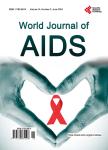Evaluation of the Third 90 of the 90-90-90 Cascade for the Period 2019-2020 in the Central African Republic
Evaluation of the Third 90 of the 90-90-90 Cascade for the Period 2019-2020 in the Central African Republic作者机构:Laboratory of Medical Analysis of the Institut Pasteur of Bangui (IPB) Bangui Central African Republic Epidemiology Unit of the IPB Bangui Central African Republic National Tuberculosis Reference Laboratory IPB Bangui Central African Republic
出 版 物:《World Journal of AIDS》 (艾滋病(英文))
年 卷 期:2021年第11卷第4期
页 面:189-198页
学科分类:1004[医学-公共卫生与预防医学(可授医学、理学学位)] 100401[医学-流行病与卫生统计学] 10[医学]
主 题:HIV ARV Viral Load Suppression 90-90-90 Target Central African Republic
摘 要:Introduction In Central-African Republic, according to UNAIDS in 2019, out of approximately 100,000 people living with HIV, 70% (72,000) knew their HIV status and 47,000 (46%) were on ARV therapy;however, there is a paucity of data on viral load suppression in people on ARV therapy. The objective of this study was to assess the third 90 of the UNAIDS strategy for the years 2019 and 2020 in the CAR. Methods We analyzed the available viral load data extracted from the data base of the medical analysis laboratory (SYSLAM) of the Institut Pasteur of Bangui for the years 2019 and 2020. The viral loads were determined based on plasma collected in an EDTA tube with Cepheid’s GeneXpert® 16-module controllers. Viral load data were extracted from SYSLAM, converted to Excel format, and analyzed with STATA version 14 software. The significance threshold for the statistical tests was set at 5%. Results This study included 22,895 patients, of who 72% were female. The average age was 40.82 years, and the majority of the patients (80%) came from the city of Bangui. Regarding the virological parameters associated with this study, 66% of the patients had significant viral load suppression according to the WHO recommendations and 34% were in virological failure. Patients over 50 years of age (71.85%) and age group 40 - 49 years (69.25%) recorded significant levels of viral load suppression. On the other hand, 63.45% of patients under 18 years of age had virological failure. All of these results were statistically significant (p Conclusion There should be a concerted effort, to make viral load accessible and available to all patients receiving ARV treatment in the CAR and the management of HIV/AIDS infection of children and adolescents should be given special attention.



